THATCH ACCUMULATION IN A LAWN
What Causes Thatch Buildup in a Lawn?
What is Thatch?
Thatch is a layer of dead grass stems, roots, and organic matter that accumulates between the soil surface and the green grass blades. A healthy lawn relies on soil microbes, fungi, and beneficial bacteria to break down this organic material and convert it into nutrients for the grass. A thick thatch layer prevents water, air, and nutrients from reaching the roots, leading to shallow root growth, increased pest and disease risk, and a less resilient lawn.
Thatch Buildup Occurs When Microbial Activity is Lacking
When microbial activity is low or absent, decomposition slows down, and thatch begins to build up faster than it can break down. This can happen due to:
- Overuse of synthetic fertilizers – Excess nitrogen can encourage rapid grass growth but suppress microbial diversity.
- Soil compaction – Limits air, water, and microbial movement in the soil.
- Low soil moisture – Microbes need moisture to thrive and break down organic matter.
- Excess pesticide or fungicide use – Kills off beneficial microorganisms that help with decomposition.
- Poor soil aeration – Reduces oxygen availability, which microbes need to function.
Thatch in a Lawn
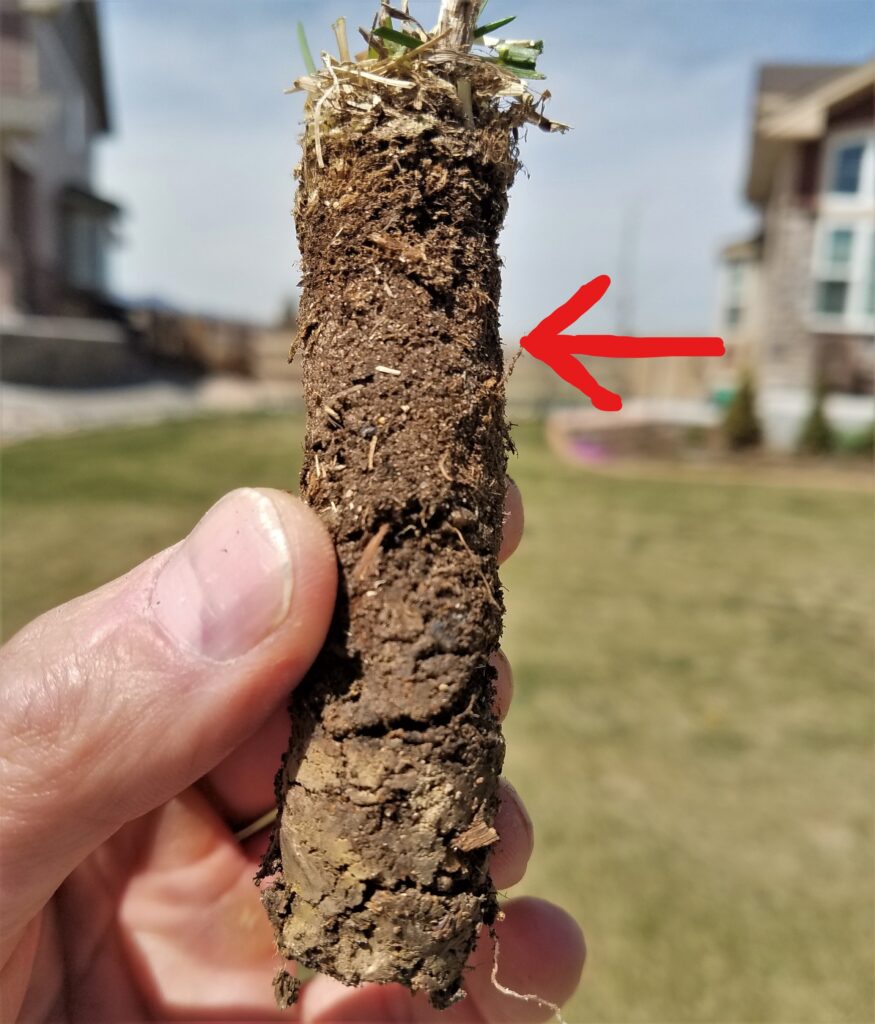
Poor Cultural Practices That Damage Microbes
- Shallow or frequent lawn watering practices.
- Severe overwatering of the lawn.
- Fertilizing the lawn with fast-release nitrogen. Salt-based nitrogen like those found in synthetic fertilizer sources will kill microbes in the soil.
- Mowing the lawn infrequently where more than 1/3 of the blade of grass is removed.
- The use of lawn herbicides and lawn fungicides. Both of these have been proven to kill microbial activity in soils.
- Compacted soils that have not been aerated annually.
Thatch in a Lawn
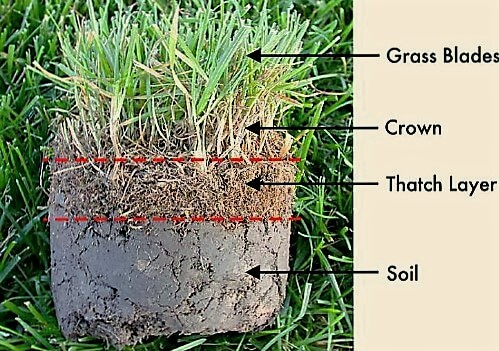
Well Managed Lawns Don't Develop Thatch!
Instead of Dethatching – Focus on Building a Healthy Soil
Dethatching is often unnecessary because a healthy lawn naturally decomposes thatch through microbial activity. Thatch, a layer of dead grass stems, roots, and organic matter, only becomes a problem when it exceeds ½ inch in thickness. In a well-maintained lawn, soil microbes, earthworms, and beneficial fungi break down thatch efficiently, preventing excessive buildup.
Reasons Dethatching is Unnecessary
- Microbial Breakdown – Organic lawns have an abundance of microbes that naturally decompose thatch.
- Proper Lawn Care Prevents Buildup – Aeration, compost, and organic fertilizers promote healthy soil life that keeps thatch under control.
- Grass Clippings Decompose Quickly – Unlike woody stems, fresh grass clippings add nutrients to the soil and do not contribute to thatch.
- Dethatching Can Damage the Lawn – Mechanical dethatchers rip out healthy grass and roots, causing unnecessary stress and slow recovery.
Better Alternatives to Dethatching
- Encourage Soil Microbes – Apply compost and organic matter to feed beneficial microbes.
- Core Aeration – Improves airflow and helps microbes break down thatch naturally.
- Mow Properly – Keep blades sharp and mow at the right height to avoid excess thatch formation.
- Avoid Chemical Fertilizers – Too much fast release nitrogen can cause excessive thatch buildup and kill microbes in the soil.ost
Core Aeration
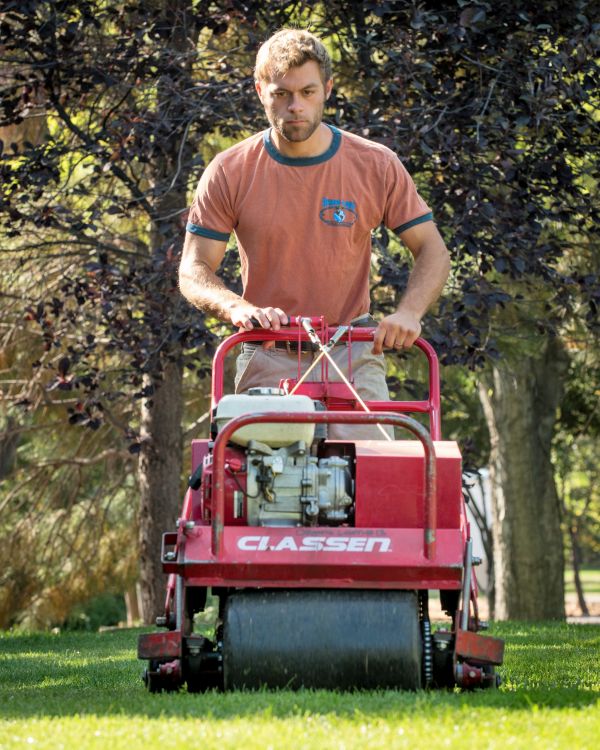
Managing Thatch in a Lawn
What Causes of Thatch Buildup
- Overwatering – Causes shallow root growth and replaces air in the soil. Without oxygen the microbes will die.
- Overfertilization – Especially with synthetic nitrogen-heavy fertilizers, which can encourage rapid grass growth but slow down microbial decomposition.
- Grass Type – Some grass species, like Kentucky bluegrass, naturally produce more thatch.
- Poor Soil Aeration – Compacted or heavy clay soils hinder microbial activity, slowing the breakdown of organic material.
- Low Microbial Activity – A lack of microorganisms in the soil reduces decomposition of organic matter.
Signs of Excess Thatch
- The lawn feels spongy when walked on.
- Grass struggles to grow evenly or appears stressed despite adequate watering and fertilization.
- Water gets stuck in the thatch instead of soaking into the soil.
- Brown patches or thinning grass, especially during heat stress.
Severe Thatch Accumulation
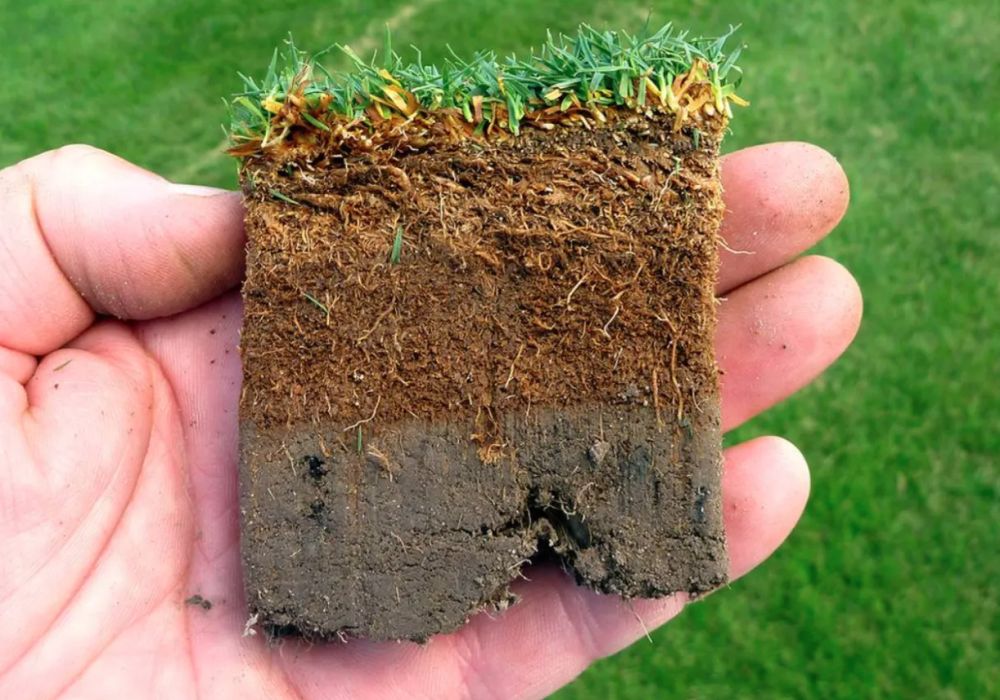
Thatch Prevention and Management
Preventative Measures
Proper Mowing
- Cut grass tall to promote deeper digging grass roots.
- Avoid cutting more than one-third of the grass blade at a time.
Water Correctly
- Follow the 1-2-3-2-1 technique by watering deeply and infrequently to encourage deep root growth.
- Avoid daily watering.
- The lawn might look worse before it looks better after adjusting the lawn watering.
Avoid Over Fertilization and Chemicals
- Use organic fertilizers and avoid overuse of nitrogen.
Core Aeration
- Aeration improves soil drainage and promotes microbial activity to decompose organic matter.
Encourage Microbial Activity
- Add compost or organic matter to boost soil health and microbial life.
Proper Lawn Watering

Treatment Plan for Lawns with Severe Thatch
Short-Term and Long-Term Solutions
Dethatching or Power Raking
- Use a dethatching rake to mechanically remove excessive thatch is a powerful tool if used properly.
- Using a power rake is only a short-term solution to the long-term problem of thatch buildup if the underlying cause is not properly addressed.
Core Aeration
- Use a core aerator to remove soil plugs and introduce oxygen into the soil. Double aeration may be necessary for lawns with a severe thatch problem.
Compost Topdressing
- Applying a hiqh quality organic compost after aeration is a wonderful tool to quickly introduce millions if not billions of beneficial microbes to quickly improve soil structure.
Long-Term Solution
Thatch buildup should not occur if the soil is teaming with microbes. You can prevent thatch buildup and keep your lawn thriving with proper mowing, watering, and organic fertilization.
Organic Compost

Thatch in a Lawn FAQs
How Much Thatch is Too Much Thatch?
A healthy lawn should have no more than ½ inch of thatch. Anything above ½ inch can start to cause problems by blocking water, nutrients, and air from reaching the soil and roots.
Signs of Too Much Thatch (Over ½ Inch)
- Water gets stuck in the thatch layer and never reaches the soil.
- Grass feels spongy or bouncy underfoot.
- Increased lawn diseases like Necrotic Ring Spot fungus and insect pressure like (grubs).
- Grass struggles to absorb nutrients, leading to yellowing or weak growth
How to Measure Thatch Thickness
- Use a shovel or soil probe to remove a small section of grass and soil.
- Look for the spongy, brown layer between the green grass and soil.
- Measure the thickness – if it’s over ½ inch, it’s time to take action!
1/2 Inch of Thatch or Less is Perfectly Healthy
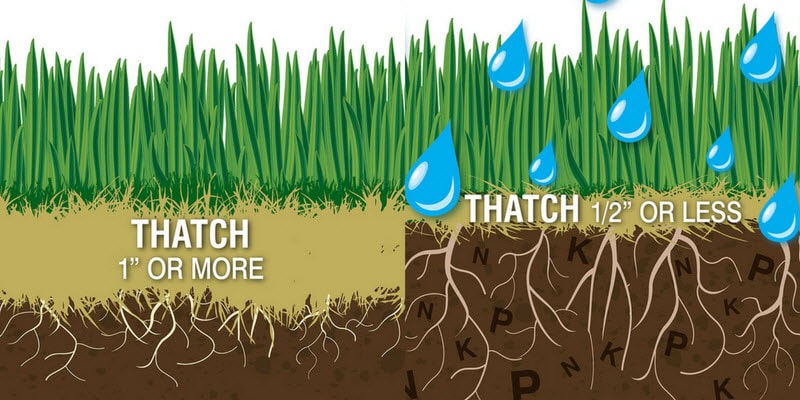
Additional Thatch FAQs
For Cool-Season Grasses (Kentucky bluegrass, fescue, ryegrass) – Early spring before the lawn has started to turn green for the season.
If your grass feels spongy or bouncy, water runs off instead of soaking in, or your lawn struggles despite proper care, you might have excessive thatch (over ½ inch thick). Check by digging a small section or use a soil sampler—if the thatch layer is greater than ¾”, it’s time for aeration and compost to break it down.
Some thatch can be beneficial; up to 1/2 inch of thatch is good because it insulates the soil and helps retain moisture in the ground for a longer period.
If a power rake is not used correctly, it can harm the lawn. That’s why we discontinue this service after April 1st and recommend that the process only be carried out by a professional who understands the associated risks. We offer power raking as a last resort for reducing thatch density.
Grass clippings do not directly contribute to thatch buildup. Instead, thatch is a symptom of an underlying issue: a lack of beneficial microbial activity in the soil. Without sufficient microbes, organic matter—such as lawn clippings and decaying grass roots—will not decompose properly, leading to the formation of a thatch layer.
- Core Aeration – The best method to break up thatch and improve airflow.
- Topdressing with compost – Encourages microbial decomposition.
- Encourage microbial activity – Healthy soil life naturally reduces thatch.
- Power raking (only if absolutely necessary) – Should be done in early spring or fall for cool-season grasses, and late spring for warm-season grasses.
Usually not! In most cases, proper lawn care prevents thatch buildup naturally. Dethatching machines can damage grass and roots, so it should only be used if thatch is excessively thick.